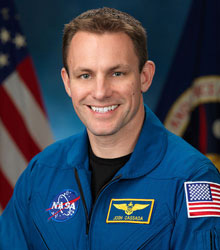Astronaut Cassada, ’95, Aims to Spread Message of Science’s Wonders
Homecoming Weekend visit includes October 16 public lecture.
October 14, 2015
By Chuck Carlson

Josh Cassada earned his Ph.D. in physics at the University of Rochester before launching a distinguished career as a Navy pilot. “I love teaching; I always have,” he says. “I sometimes think of myself as a scientist wrapped in a pilot’s body.”
On Friday afternoon, October 16, NASA Astronaut and Lt. Commander, U.S. Navy, Josh Cassada, ’95, will look out into a sea of young faces and wonder if and when, and perhaps most important, why not?
“People ask me all the time if I’m going to Mars,” said Cassada, who was selected in June 2013 as one of the eight members of NASA’s 21st astronaut class. “I’m not going to Mars but the person going to Mars is probably in elementary school right now and that’s pretty cool.”
And will one of those Mars voyagers be sitting in front of him Friday morning at Albion’s Community School Auditorium, inspired by Cassada’s message and background and desire?
Anything is possible, Cassada said, and that’s the beauty of it all.
“I’m excited about what we’re doing, especially in science,” Cassada said. “And hopefully that’s contagious. We don’t know what we’re going to learn, and that’s exciting.”
Cassada, a native of White Bear Lake, Minnesota, who earned his B.A. in physics at Albion College, returns to campus this weekend as part of annual Homecoming festivities and to celebrate his class’ 20-year reunion.
Escorted by one of his former professors, Dave Seely, Cassada on Friday will talk with first-year students in Charles Moreau’s Physics 167 class at 9:15 a.m., followed by a 10:30 a.m.-to-noon meeting with local elementary kids at the Community School.
Then from 2:15 to 3 p.m. there will be a physics seminar in Norris 101, open to the public, where he will talk and, more to his liking, take questions about NASA, space and his favorite subject, the wonders of science.
On Saturday, he’ll mingle with Homecoming guests, attend the football game, meet with old friends and science faculty, and then return to the grueling training that, he hopes, will lead to his first space mission.
Cassada, 42, isn’t sure when his first trip to space will be but is all but certain it will eventually involve a six-month mission on the International Space Station, where various experiments will be conducted and research done to continue laying the groundwork for a possible manned mission to Mars.
“The International Space Station is the stepping stone to the next great thing,” Cassada said.
For now, U.S. access to the space station requires launching on a Russian Soyuz rocket and working closely with Russian cosmonaut crewmembers, so along with everything else he must train for, he’s taking a crash course in learning the Russian language.
Asked if he knew when he might get his chance in space, he said, “It would probably be four years before I go in orbit. Or it could be 10 years.”
The timeframe is partially based on how successful the missions to follow will be, how long the current partnership with the Russian Space Agency is maintained, and how well development of new crew transportation systems progresses for the two U.S. companies, SpaceX and Boeing, both selected by NASA to design new commercial crew vehicles. If all goes well, these companies will provide future transportation services to deliver and return astronauts to and from the space station.
But whatever the future holds, training as an astronaut has allowed Cassada to embrace his two passions—teaching physics and flying.
In fact, he had planned to take a position as adjunct physics professor at Albion before he was selected as an astronaut. And, one day, he expects to go back to teaching.
“I love teaching; I always have,” he said. “I sometimes think of myself as a scientist trapped in a pilot’s body.”